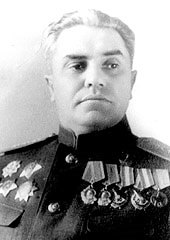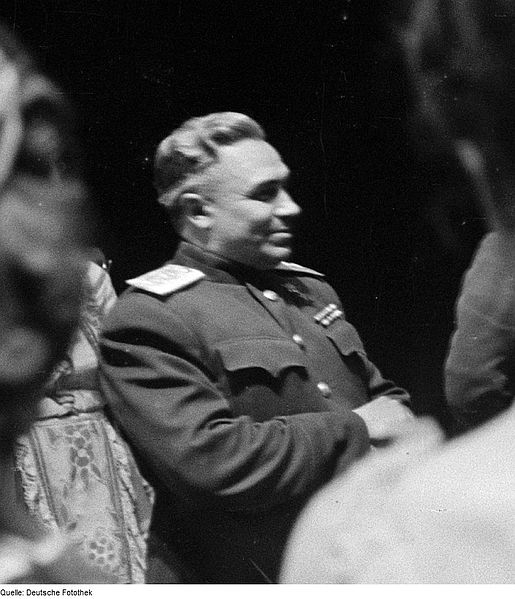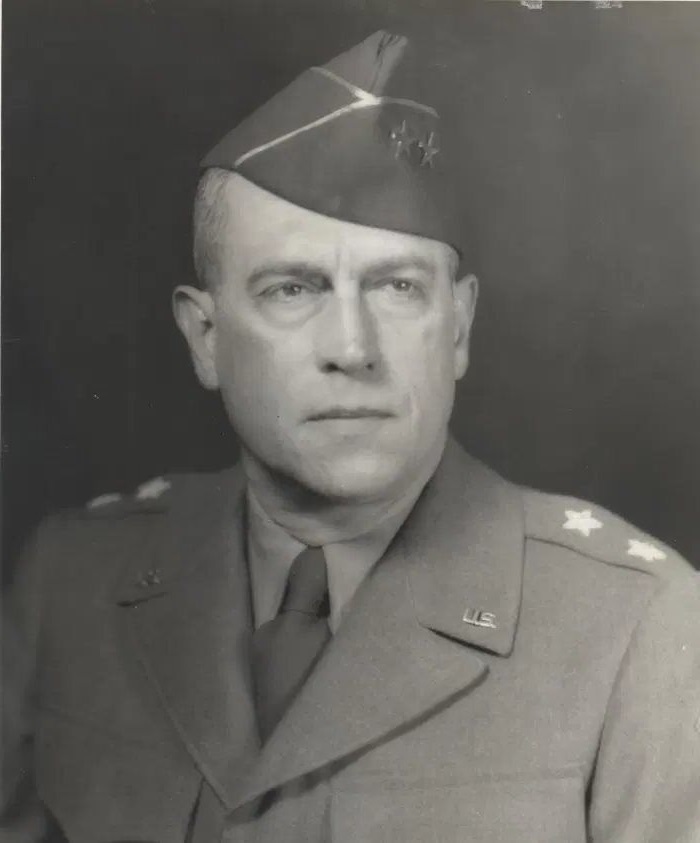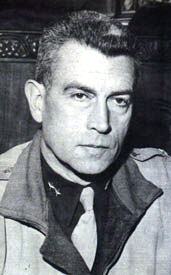<Back to Index>
- General of the Red Army Nikolai Erastovich Berzarin, 1904
- Major General of the U.S. Army Maurice Rose, 1899
PAGE SPONSOR


Nikolai Erastovich Berzarin (Russian: Никола́й Эра́стович Берза́рин; 1 April 1904 - 16 June 1945) was a Red Army colonel general who held field army commands during World War II. A Hero of the Soviet Union, in 1945 he became the first commandant of the Soviet occupying forces in Berlin.
Nikolai Erastovich Berzarin was born in Saint Petersburg on 1 April 1904, the son of a Putilov Factory lathe operator and a seamstress. He had one brother and three sisters. In 1913 he began night courses at the city primary school, completing these in 1914 with the specialty of bookbinder. Berzarin worked as an unskilled laborer at the Saint Petersburg harbor. His father died in 1917, followed by his mother in 1918.
Berzarin joined the Red Army on 14 October 1918,
beginning his service as a Red Army man in the 17th
Petrograd Army Combat Sector. During the Russian Civil War
he fought on the Northern Front against Allied troops in Archangelsk and in the
suppression of the Kronstadt rebellion.
Berzarin received command training at the 2nd Petrograd Infantry Command Courses and upon graduation in September 1923 was appointed a squad leader in the 5th Amur Rifle Regiment. Berzarin rose to command a platoon in the regimental school in March 1924, and fought in the destruction of Zazeyskoye uprising in Amur Oblast that year as assistant chief of a machine gun detachment. In 1925, he married bank employee Natalya Porosinyuk, with whom he had two daughters, Larissa and Irina. He graduated from machine gun courses at the Vystrel courses for command personnel in 1925 and became a member of the Communist Party in 1926. After graduating from the Command Courses of the Siberian Military District in October 1927, Berzarin commanded a platoon of the courses and in October 1928 became a class commander there.
Berzarin rose to command a training company at the Irkutsk Infantry School in April 1931. He served as responsible secretary of the party bureau of the Irkutsk Training Courses for Infantry Commanders from March 1932, and in July 1933 became assistant chief of the combat training department of the staff of the Special Red Banner Far Eastern Army. He became commander of the 77th Novgorod Rifle Regiment of the army's 26th Rifle Division in February 1935, receiving the rank of colonel when the rank was introduced in late 1935, and in August 1937 chief of the 2nd Department of the staff of the army's Primorsky Group of Forces. During the Great Purge in 1938, the NKVD tried to implicate Berzarin in the case of the executed commander Ivan Fedko but the case was closed due to lack of evidence. That year, his daughter Irina was born. In July, freshly appointed commander of the 32nd Rifle Division the previous month, Berzarin took part in the Battle of Lake Khasan. He was promoted to kombrig on 31 December 1938.
After Lake Khasan, Berzarin's career developed quickly:
he was appointed commander of the 59th Rifle Corps in
February 1939 and deputy commander of the 1st Red Banner
Army of the Far Eastern Front in July 1940. Berzarin's
rank was changed to major general when the Red Army
introduced general officer ranks on 4 June 1940. In May
1941, he was appointed commander of the newly formed 27th
Army, stationed at Riga in the Baltic
Special Military District.
After Germany invaded the Soviet Union, Berzarin commanded the army as part of the Northwestern Front in the Baltic strategic defensive operation, during which it defended the Baltic Sea coast. The army entered action in July and was forced to retreat to the lines of the Western Dvina, Velikaya, and Lovat rivers under the pressure of the German advance. The 27th Army counterattacked near Kholm in August and subsequently fought in defensive actions near Demyansk, stopping the German advance on the line of Lakes Velye and Seliger in early October. Berzarin was transferred to command the 34th Army of the front in December, leading it in the encirclement of German troops in the Demyansk Pocket during February 1942, but was unable to prevent the relief of the pocket in May. Berzarin was demoted to deputy commander of the 61st Army of the Bryansk Front in October, then served as deputy commander of the 20th Army from 4 January 1943. Berzarin distinguished himself in the fighting in the Battles of Rzhev and the Rzhev - Vyazma Offensive in March. During the latter, he was seriously wounded near Vyazma on 17 March and spent several months in the hospital. Berzarin was promoted to the rank of lieutenant general on 28 April.
Upon his recovery, Berzarin was returned to army command, taking over the 39th Army in September. He led the army as part of the 1st Baltic and 3rd Belorussian Fronts in the Smolensk operation and the winter offensive battles of 1943 and 1944 near Vitebsk.
Berzarin was transferred to command the 5th Shock Army of
the 3rd Ukrainian Front on 27 May. The army was
transferred north to the 1st Belorussian Front in October
and Berzarin led it in the Vistula - Oder offensive that
began in January 1945. For his command of the army in the
offensive, Berzarin was made a Hero of the Soviet Union on
6 April. He was promoted to the rank of colonel general on
20 April.
During the Battle of Berlin, Berzarin's 5th Shock Army reached the eastern outskirts of Berlin on 21 April 1945, making them the first Soviet Army to do so. On 24 April, he was appointed commander of the city by Marshal Zhukov, in an echo of the Tsarist tradition of rewarding the first commander to enter a city with command over it. By his "Order No. 1" on 28 April, Berzarin assumed all governmental power. He worked to re-establish order in the ruined German capital, creating a city police force and supplying the population with food, water, gas and electricity, as well as re-opening schools and theaters. On 17 May, he appointed non-partisan Arthur Werner the first post-war Mayor of Berlin presiding over a civil city government.
On 16 June 1945, after only 55 days in office, he was
killed in a motorcycle accident when he collided with a
truck convoy near his office in Berlin - Friedrichsfelde,
aged 41. Berzarin is buried in the Novodevichy Cemetery in
Moscow.
In 1975 Berzarin posthumously was bestowed honorary citizenship of East Berlin. After German reunification he was formally removed from the roll of honorary citizens by the Senate of Berlin in 1992.
Upon a resolution by the Berlin Abgeordnetenhaus parliament, he regained his honorary citizenship in 2003, in view of his merits concerning the supply of the local population. Detractors of the re-awarding claimed that Berzarin was a Stalinist and involved in Soviet war crimes being responsible for the deportation of 47,000 Balts in 1940. These accusations, however, were proven wrong later on, as Berzarin was deployed in Vladivostok at the questioned time.
From 1947 until 1991 Petersburger Straße in Berlin - Friedrichshain, a section of the Inner Ring Road, was named Bersarinstraße in his honor, the Bersarinplatz roundabout bears his name up to today. In April 2005, a road bridge in Berlin - Marzahn was named after Berzarin, in the area where his army reached the Berlin city limits in 1945. A birch tree planted in 2005 and a memorial stone mark the (presumed) site of his motorcycle accident.


Maurice Rose (November 26, 1899 - March 30, 1945) was a career officer in the United States Army who attained the rank of major general. A veteran of World War I and World War II, Rose was commanding the 3rd Armored Division when he was killed in action in Germany during the closing days of the war.
The son and grandson of rabbis from Poland, Rose was at the time the highest-ranking Jew in the U.S. Army, though he was not especially religious, did not publicize his faith, and claimed in his Army records to be Protestant. He was also the highest ranking American killed by enemy fire during World War II in the European Theater of Operations. Rose was married twice and had two sons.
The 3rd Armored Division's official history of World War
II memorialized Rose by stating "He was over six feet
tall, erect, dark haired, and had finely chiseled
features. He was firm and prompt of decision, brooking no
interference by man, events or conditions in order to
destroy the enemy."
Rose was born in Middletown, Connecticut on November 26, 1899, the son of Rabbi Samuel Rose and Katherin "Katy" (Bronowitz) Rose. In 1902, the Rose family relocated to Denver, Colorado, where Rose was raised and educated. He attended East High School, where he was editor of the school newspaper and graduated with honors in 1916. His desire for a military career became well known among his classmates; in the school yearbook, a cartoon illustrating the newspaper staff depicted him carrying a rifle.
Rose lied about his age to enlist in the Colorado National Guard as a private after graduating from high school in 1916, hoping to serve in the Pancho Villa Expedition. He was discharged six weeks later when his commander was informed that he was underage.
Rose worked for a year in a meatpacking plant where one
of his brothers was employed, and enlisted again in 1917
after he obtained his parents' permission. Rose was soon
selected for officer training, and falsely claimed to have
been born in 1895 so that he would appear to meet the
minimum required age of twenty-one. After graduating from
Officer Candidate School (OCS) at Fort Riley, Kansas, in
August 1917, four months after the American entry into
World War I, Rose was commissioned as a Reserve second
lieutenant of Infantry.
Rose was assigned to command a platoon in the 353rd Infantry Regiment, a unit of the 89th Division. The division was organized and trained at Camp Funston to prepare for service in France, and in December 1917 he was promoted to temporary first lieutenant. In May 1918, the division traveled by train to Camp Mills, New York, and it departed for Europe by ship in June. Later that month, the 89th Division arrived in Liverpool, England and a week later they arrived in France.
The 89th Division completed additional training until August, when it relieved the 82nd Division in the Lucey sector, near the city of Toul. Rose's battalion of the 353rd Infantry took up defensive positions near Metz, where they began preparations to participate in the Meuse - Argonne offensive. Rose took part in combat throughout the offensive, and was wounded at St. Mihiel, including being hit by shrapnel during a German mortar and artillery barrage, as well as sustaining a concussion. He initially refused to be evacuated, but he collapsed from exhaustion. Medics removed him from the battlefield, and he was taken to the 89th Division's hospital near the village of Flirey.
After a few days of convalescence, Rose left the hospital
against medical advice and returned to his unit. With
medical officials unsure of his whereabouts, the Army
reported to Rose's parents that he been killed, an error
which took several days to correct. Rose continued to
serve with the 353rd Infantry until the war ended in
November due to the Armistice with Germany. He remained in
Germany as part of the Army of Occupation, and was
discharged in June 1919.
After leaving the Army, Rose accepted a position as a traveling salesman with Hendrie & Bolthoff, makers of mining and manufacturing equipment and supplies. His territory included Utah, and he rented a room in Salt Lake City.
During a visit to the post quartermaster at nearby Fort Douglas, Rose learned that while the army carried out a post war reorganization, it was accepting a limited number of lieutenants and captains for return to active duty. On July 1, 1920, he re-joined the peacetime army as a second lieutenant, which was then adjusted to first lieutenant in recognition of his wartime rank. On the following day, he was promoted to captain. Rose served initially with the 20th, 21st, 53rd and 38th Infantry Regiments at Fort Douglas. In 1924, he was the adjutant of the 38th Infantry. While stationed at Fort Douglas, his duties included organizing and overseeing annual Citizens Military Training Camps, which were designed to expose young men without military service to the experiences of Army life.
In 1927, Rose was assigned to Kansas State University as a Reserve Officers' Training Corps instructor, and his additional duties included coaching rifle marksmanship for both men's and women's teams. In 1931 and 1932, he was serving with the 8th Cavalry Regiment at Fort Bliss, Texas. In the summer of 1932, Rose was one of the Army officers assigned to provide instruction at the annual training encampment of the New Mexico National Guard. Rose was assigned to duty as adjutant of the Corozal Military Post on the Pacific side of the Panama Canal Zone beginning in February 1933. He served with the 6th Cavalry Regiment at Fort Oglethorpe, Georgia, from August 1935 to August 1936.
Rose was promoted to major in 1936. From 1937 to 1939 he was an observer and advisor for the Pennsylvania National Guard. In 1939 Rose was posted to Fort George G. Meade, Maryland, as an instructor at the Third Corps Area Command and Staff School.
In addition to his completion of Officer Candidate School in
1917, Rose graduated from the Infantry
Company Officer Course (1926) and the Cavalry Officer
Course (1931). He was a 1937 graduate of the Command and
General Staff College, and he graduated from the Army Industrial College in
1940.
From July 1940 to July 1941 Rose was assigned to Fort Knox, Kentucky and commanded 3rd Battalion, 13th Armored Regiment as a lieutenant colonel. In 1941, he was assigned as executive officer of 1st Armored Brigade, a unit of the newly organized 1st Armored Division. After observing the brigade in action, newspaper reporter Keyes Beech referred to Rose as "probably the best looking man in the army."
In early 1942, Rose was chief of staff for the 2nd Armored Division at Fort Benning, Georgia. He continued as chief of staff after the division arrived in North Africa and was promoted to colonel. When German forces in Tunisia were reduced to combat ineffectiveness, Rose negotiated with their commander, Fritz Krause, on the details of their unconditional surrender.
Promoted to brigadier general, Rose was assigned to lead Combat Command A, 2nd Armored Division, which he commanded in combat throughout fighting in Sicily. When Leroy H. Watson was relieved as commander of the 3rd Armored Division during combat in France in August 1944, Rose succeeded him and was promoted to major general.
After assuming command of the division, Rose became known
for his aggressive style of leadership, directing his
units from the front rather than a rear command post.
Following the 1944 Allied breakthrough on the French
coast, the 3rd Armored Division dashed through Belgium and
was the first tank unit to enter Germany, and the first to
breach the Siegfried line.
3rd Armored helped stem the German offensive in the
Ardennes during the Battle of the Bulge, and was the first
armor unit to enter Cologne.
On March 30, 1945, Rose was riding with members of his staff at the front of a 3rd Armored column a few miles south of the city of Paderborn in a rural forested area. Receiving reports of units being cut off by German troops, they turned around to investigate, and suddenly began taking small arms, tank and anti-tank fire. Rose and his staff jumped into a nearby ditch as the tank leading their column took a direct hit and was destroyed. When they realized that they were being surrounded by German tanks of the SS Brigade Westfalen they re-mounted their vehicles and attempted to escape, driving off the road and through a nearby field. As they turned back onto the road they saw it was occupied by more German tanks.
Recognizing that they were about to be cut off, the driver of the lead jeep in Rose's party accelerated and narrowly made it past the German tanks. The driver of Rose's jeep attempted the same maneuver, but one of the German tanks succeeded in cutting them off. Rose and the other passengers dismounted, and the German tank commander opened his hatch and aimed a machine pistol at them. Rose reached towards his holster, either to surrender his pistol or attempt to fight his way out. The German tank commander then shot several times, with 14 rounds hitting Rose, including several in the head. The other passengers from Rose's jeep ran into the woods, hid overnight, and were reunited with friendly units the next morning. They later returned to retrieve Rose's body and the documents he was carrying. Rose was buried at Netherlands American Cemetery and Memorial.
Investigators led by Leon Jaworski later looked into
whether Rose's death could be considered a war crime,
which might have been the case if Rose and his staff were
shot while attempting to surrender. The investigation
concluded that the German tank crew probably believed Rose
intended to fight, and had no idea they had killed a high
ranking commander, because his body and several sensitive
documents he was carrying were not removed from his jeep.
Rose was the highest ranking American killed by enemy fire
in the European Theater of Operations during the war.
In 1920, Rose married Venice Hanson (1895 - 1962) of Salt Lake City. They separated in 1928 or 1929, and divorced in 1931. Maurice Rose and Venice Hanson were the parents of a son, Maurice "Mike" Rose (1925 - 2010), a career officer in the United States Marine Corps who attained the rank of colonel and was a veteran of World War II, the Korean War and the Vietnam War.
Rose married Virginia Barringer (1912 - 1997) in 1934. They were the parents of a son, Maurice Roderick "Reece" Rose (1941 - 2020) who spent his career in law enforcement, including service as chief of police for the San Antonio International Airport.
Rose was raised in a Jewish household; his father was a
businessman who operated a dress design shop with Rose's
mother and later became a rabbi. Rose had a bar mitzvah and could speak
Yiddish and read Hebrew. Though brought up Jewish, and
identified as Jewish in post World War I newspaper
articles that recorded the bravery of Jewish U.S. Army
soldiers, he began to identify himself as Protestant in
military records soon afterwards. Biographers and
researchers believe he could have undergone a religious
conversion, though there are no records to substantiate
this. Instead, they believe it is more likely that Rose
was not especially religious as an adult, and claimed
Protestantism in his military records as a way to
assimilate with his peers and increase his chances for
advancement as his career progressed. Rose's grave marker
is a Christian cross, but Rose is still regarded as a
significant figure in U.S. Jewish history.
J. Lawton Collins, Rose's superior as commander of the VII Corps, regarded Rose "as the top notch division commander in the business at the time of his death." However, Rose never gained the prominence of many of his contemporaries, for reasons including the fact that he did not survive the war, and as an intensely private man, he rarely if ever sought personal publicity.
His biographers, Steven L. Ossad and Don R. Marsh, referred to Rose as "World War II's Greatest Forgotten Commander". Andy Rooney, a World War II war correspondent and later 60 Minutes commentator, wrote in his book My War:
Maj. Gen. Maurice Rose, who had been with the Second Armored Division at Saint-Lô, was now the commander of the Third Armored and he may have been the best tank commander of the war. He was a leader down where they fight. Not all great generals were recognized. Maurice Rose was a great one and had a good reputation among the people who knew what was going on, but his name was not in the headlines as Patton's so often was. Rose led from the front of his armored division.
Rose's birthplace in Middletown, Connecticut is marked with a plaque as part of the city's Main Street Historic District, which is listed on the National Register of Historic Places. The Armed Forces Reserve Center in Middletown is also named for Rose, as is the Connecticut Route 9 bridge over Union Street in Middletown.
Rose Terrace and Rose Hall at Fort Knox were named for Rose. The army transport USAT General Maurice Rose, the Rose Medical Center in Denver, Colorado, and the primary school in Margraten, Netherlands were named in his honor. In addition, the now closed Maurice Rose Army Airfield near Frankfurt, Germany and Rose Barracks near Vilseck, Germany were also named for him.
The 1951 film The Tanks Are Coming depicts five tanks of the 3rd Armored Division as they advance across France into Germany during World War II. The commanding general of the division is not named, but is presumed to be Rose based on the film's timeline and the fact that the character was portrayed by Roy Roberts, an actor who physically resembled Rose.